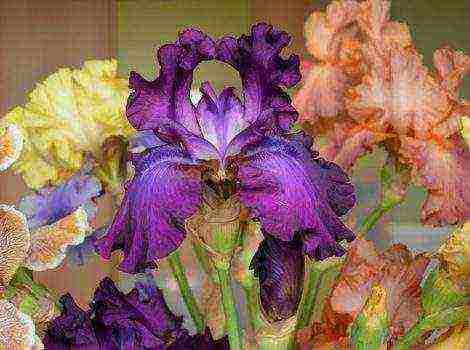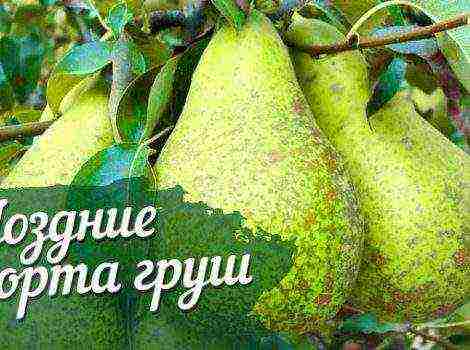Content
- 1 Description of pepper Jubilee F1, reviews, photos
- 2 Agrotechnics for growing bell peppers
- 3 Description of sweet pepper varieties
- 4 How to grow ground pepper
- 5 Hybrid and variety - what is the difference
- 6 Varieties and their characteristics
- 7 Early varieties of bell pepper for open field
- 8 Mid-season
- 9 Sweet pepper for Siberia
- 10 Varieties for the Moscow region
- 11 The best hybrid varieties
- 12 Description of the best late-ripening peppers
- 13 Thick-walled large-fruited varieties
- 14 The best peppers for stuffing and processing
- 15 Conclusion
Description of pepper Jubilee F1, reviews, photos
An early, high-yielding, undersized hybrid of bell pepper for growing in open ground, film tunnels, greenhouses. The period from germination to the beginning of ripening is 120-135 days.
The bush is compact, standard, 50-60 cm high.
Fruit characteristics
Fruits are drooping, truncated-pyramidal, large ribbed, light green at the stage of technical ripeness, red at biological ripeness, weighing 120-150 grams, juicy, good taste without bitterness. Wall thickness 5-8 mm. This pepper has a universal purpose - it is suitable both for fresh consumption and for canning, home cooking, freezing.
The hybrid is tolerant to tobacco mosaic and verticillary wilt.
Yield in film shelters 5-7 kg / m2, in glass greenhouses - 8-10 kg / m2.
Hybrid advantages: high yield, long fruiting period, high palatability of fruits, resistance to diseases.
Jubilee pepper Semko is included in the State Register of the Russian Federation.
Agrotechnics for the cultivation of bell peppers
Sowing for seedlings is carried out in late February - early March. The pick is done in the phase of 1-2 true leaves.
It is recommended to grow pepper seedlings within 60 days from germination and plant in the budding phase.
Seedlings are planted in the greenhouse in mid-May, and in open ground in early June, after the threat of return frosts has passed. Landing scheme 40 x 60 cm.
Remember that pepper is thermophilic, and also picky about the fertility and moisture of the soil.
Top dressing of sweet pepper Jubilee Semko
In the process of growth and fruiting of pepper, it is necessary to introduce additional fertilizers into the soil:
- 1st feeding a couple of weeks after planting. Apply a solution of superphosphate at the rate of 2 teaspoons per 10 liters of water. One bush takes about a liter of solution.
- 2nd feeding is carried out during flowering. The previous composition of the solution can be supplemented with 1 teaspoon of potassium sulfate and 1 teaspoon of carbamide, and the dose of superphosphate can be doubled.
- The third feeding occurs during the ripening period of the peppers. For 10 liters of water, take 2 teaspoons of superphosphate and the same amount of potassium salt.
If you have grown Jubilee Semko sweet pepper, please write whether you like it or not. What was the yield and taste of the fruit in your climatic conditions? If possible, attach a photo of the pepper.
Your reviews about Jubilee pepper, as well as additions to the description, will help many gardeners evaluate this hybrid objectively and decide whether to plant it or not.
Among the modern variety on the seed market, you can pick up a wide variety of sweet peppers, which will differ not only in color, size, taste and aroma, but also in terms of fruiting and growth patterns. Since the ripening period for this plant is longer than the duration of the warm summer period, most gardeners, both amateurs and professionals, plant mainly super-early and early varieties of sweet pepper.
Description of sweet pepper varieties
What are the best sweet pepper varieties for the selection of seeds and planting seedlings of pepper? From the right one sweet pepper varieties the quality of your crop will depend.
What to consider when choosing a pepper variety
According to the duration of the growing season, all varieties are divided into very early - from germination to technical ripeness less than 100 days, early 101-120 days, mid-early 121-135 days, late 136-150 days, very late - more than 150 days. However, this trait, depending on the growing conditions, varies greatly and in some years the beginning of fruiting in some varieties is shifted by 20 days or more.
Early varieties of sweet peppers
F1 Aries
Early sweet pepper variety F1 Aries
Plant 130-140 cm high. From germination to technical ripeness 90-108 days. Fruits are large, prismatic, dark red in color, weighing 290-310 g. Fruit wall thickness is up to 7 mm. Resistant to tobacco mosaic virus. Productivity is 7-14 kg per 1 m2.
Bonus
Early sweet pepper variety Bonus
The plant is 55-60 cm high. From germination to technical ripeness 85-90 days. Fruits are erect, trapezoidal, 3-4-chambered, weighing 100-120 g, wall thickness 6-7 mm. The color of the fruits in technical ripeness is ivory, in biological - from light orange to dark red. Productivity is 4-6 kg per 1 m2.
Katyusha
Early variety of sweet pepper Katyusha
The plant is 55-75 cm high, standard, does not require special shaping. From germination to technical ripeness 100-105 days. The fruit is drooping, 2-3-chambered, glossy, with a wall thickness of 5.5 mm, weighing 100 g. Color in technical ripeness is light green,> in biological ripeness - yellow. Productivity 3.0-3.5 kg per 1 m2.
F1 Cardinal
Early sweet pepper variety F1 Cardinal
The plant is 100 cm high. From germination to technical ripeness 86-97 days. Fruits are large, cuboid, purple, weighing 250-280 g. Fruit wall thickness is up to 8 mm. Productivity 8-14 kg per 1 m2.
Nikitich
An early variety of sweet pepper Dobrynya Nikitich
Standard plant, 45-60 cm high. From germination to technical ripeness 95 - 110 days. The fruits are drooping, trapezoidal, glossy, weighing 120 g, with a wall thickness of 5-6 mm. The color of the fruit is yellowish in technical ripeness, and red in biological ripeness. Productivity 3.6-3.9 kg per 1 m2.
Martin
Early variety of sweet pepper Swallow
The plant is 48-60 cm high. From germination to the first harvest of fruits 106-130 days. The fruit is cone-shaped, smooth, light green in technical ripeness, red in biological ripeness, weighing 70-80 g and wall thickness up to 5.5 mm. Productivity up to 6 kg per 1 m2.
F1 Latino
Early sweet pepper variety F1 Latino
Plants up to 100 cm high. From germination to technical ripeness of fruits 100-110 days. Fruits are cuboid, bright red, weighing 180-200 g. Fruit wall thickness is up to 10 mm. Productivity 7-14 kg per 1 m2, depending on growing conditions.
F1 Montero (Early Miracle)
F1 Montero early sweet pepper (Early miracle)
The plant is 100-120 cm high. From germination to technical ripeness 90-100 days. Fruits are prismatic, bright red, weighing 240-260 g. Fruit wall thickness is up to 7 mm. Productivity 7-14 kg per 1 m2, depending on growing conditions.
F1 Orange Beauty
Early variety of sweet pepper F1 Orange Beauty
Plant up to 1 m high. From germination to technical ripeness 90-95 days. The fruit is cuboid, 4-chambered. In technical ripeness it is light green, in biological it is orange. Fruit weight 180-220 g. Wall thickness 8-9 mm. Productivity 8-9 kg per 1 m2.
F1 Orange Wonder
Early sweet pepper variety F1 Orange miracle
Plants 90-110 cm high. From germination to technical ripeness of fruits 100-110 days. Large cuboid fruits, bright orange in color, weighing 230-250 g. Fruit wall thickness up to 10 mm. Productivity 7-14 kg per 1 m2, depending on growing conditions.
Orien early sweet pepper
Orien
The plant is 40-60 cm tall, compact. From germination to technical ripeness 95-100 days. Fruits are elongated, 20-24 cm long, 5-6 cm wide, weighing 125-140 g. Wall thickness 4-5 mm. The color of the fruit is light yellow in technical ripeness, and bright red in biological ripeness. Productivity 4.5-5 kg / m2.
F1 Peresvet
Early variety of sweet pepper F1 Peresvet
The plant is 50-60 cm high, compact, standard. From germination to technical ripeness 92-105 days. Fruits are 2-4-chambered, prismatic with a slight longitudinal ribbing, light green in technical ripeness, red in biological ripeness, weighing 140-150 g. Wall thickness is 5-6 mm. Productivity in the open field is 5-6 kg per 1 m2.
F1 Sonata
Early sweet pepper variety F1 Sonata
The plant is up to 100 cm high. From germination to technical ripeness of fruits 96-100 days. The fruit is cuboid, 3-4 chambered, smooth, glossy, dark green in technical ripeness, bright red in biological ripeness, weighing 180-200 g. The fruit wall thickness is up to 10 mm. Productivity 7-14 kg per 1 m2, depending on growing conditions and formation.
F1 Fidelio
Early sweet pepper variety F1 Fidelio
The plant is 90-100 cm high. From germination to technical ripeness of fruits 80-90 days. Fruits are cuboid, silvery-white, weighing 175 g. Fruit wall thickness is 7-8 mm. Productivity 7-14 kg per 1 m2, depending on growing conditions.
F1 Eldorado
Early sweet pepper variety F1 Eldorado
Early ripe, 100-120 cm high. From germination to technical ripeness of fruits 100-105 days. Fruits are prismatic and cuboid, dark green in technical ripeness, bright red in biological ripeness, weighing 170-200 g. Wall thickness 7-8 mm. Productivity 7-14 kg per 1 m2, depending on growing conditions.
F1 Jubilee Semko
Early variety of sweet pepper F1 Jubilee Semko
The plant is 50-60 cm high, compact, standard. From germination to technical ripeness of fruits 92-105 days. Fruits are 2-4-chambered, truncated-pyramidal with a slight longitudinal ribbing, light green in technical ripeness, red in biological ripeness. Fruit weight 100-120 g. Wall thickness 5-8 mm. Productivity 5-7 kg per 1 m2.
Medium early varieties of sweet peppers
Mid-early sweet pepper variety Victoria
Victoria
The plant is 40-50 cm high, half-stemmed. From germination to technical ripeness of fruits 115-128 days. Fruits are cone-shaped, wide, light green in technical ripeness, dark red in biological ripeness. The average weight of the fruit is 100-120 g, the wall thickness is 5-6 mm. Productivity up to 7 kg from 1 m2.
Mid-early variety of sweet pepper F1 Vitamin
F1 Vitamin
The plant is 50-75 cm high, standard, does not require special shaping. From germination to technical ripeness 115-120 days. Fruits drooping, conical, 2-3-chambered, glossy, weighing 100-120 g, wall thickness 5-6 mm. Fruits in technical ripeness are light green, in biological ripeness - red-orange. Productivity 4-5 kg per 1 m2.
Medium early variety of sweet pepper F1 Zarya
F1 Zarya
The plant is 55-65 cm high. From germination to technical ripeness 110-115 days. Fruits are juicy, oval-conical, drooping, weighing 100-120 g. Wall thickness up to 10 mm. Light green in technical ripeness, dark red in biological ripeness. Productivity 5-7 kg per 1 m2.
Mid-early sweet pepper variety F1 Indalo
F1 Indalo
Plants 110-120 cm high. From germination to technical ripeness of fruits 110-120 days. Fruits are cuboid, bright yellow, weighing 280-300 g. Wall thickness is up to 10 mm. - Productivity 7-14 kg per 1 m2, depending on growing conditions.
Medium early sweet pepper variety F1 Cube
F1 Cube
Plant up to 100 cm high. From germination to technical ripeness of fruits 100-115 days. Fruits are cuboid, 10 x 10 cm in size, 3–4-nested, green in technical ripeness, red in biological ripeness, weighing 150–200 g. Wall thickness is 8–9 mm. Productivity 1 9-10 kg per 1 m2.
Medium early sweet pepper variety F1 Rubik
F1 Rubik
The plant is 90-100 cm high. From germination to technical ripeness 95-110 days.Fruits are prismatic, 9 x 15 cm in size, 3-4-celled, green in technical ripeness, bright red in biological ripeness. Wall thickness 7-8 mm, weight - 180-220 g. Excellent taste. Resistant to tobacco mosaic virus. Designed for growing in all types of greenhouses and open ground in the middle lane. Productivity 7-9 kg / m2.
Medium early variety of sweet pepper Garden Ring
Garden Ring road
Standard plant, 45-55 cm high, with bouquet fruiting. From germination to technical ripeness 100-105 days. The fruit is drooping, flat-round, with pronounced lobes, 3-4-chambered, weighing 110-130 g, green in technical ripeness, dark red in biological ripeness. Wall thickness 8 mm. Productivity 4-5 kg per 1 m2.
Medium early variety of sweet pepper Yarosla
in Yaroslav
Medium early variety, From germination to fruiting 125 days. The average weight of the fruit is 85 g, the color in biological ripeness is yellow, the wall thickness is 0.5 cm. The shape of the fruit is flat-round. Productivity is 5-6 kg per 1 m2.
Mid-season sweet peppers
Alesha Popovich
Mid-season sweet pepper Alyosha Popovich
Standard plant, 55-80 cm high. From germination to technical ripeness of fruits 120-125 days. Fruits drooping, weighing 160-170 g, light green in technical ripeness, red in biological ripeness. The wall thickness is 6-8 mm. Productivity 4.6 kg per 1 m2.
Bogatyr
Mid-season variety of sweet pepper Bogatyr
The plant is 55-60 cm high. From germination to the technical ripeness of fruits 125-135 days. Fruits are cone-prism-shaped, very large, light green in technical ripeness, red in biological ripeness, weighing 150-180 g. Wall thickness 5-5.5 mm. Productivity up to 7 kg from 1 m2.
Ilya Muromets
Mid-season sweet pepper Ilya Muromets
Standard plant, 60-90 cm high. From germination to technical ripeness of fruits 125-130 days. Fruits drooping, from rectangular to trapezoidal, weighing 180-300 g, smooth. Wall thickness 5 mm.
Coloring in technical ripeness is green, in biological ripeness - red. Productivity 5.2-5.6 kg per 1 m2.
F1 Maxim
Mid-season sweet pepper variety F1 Maxim
The plant is 45-90 cm high. From germination to technical ripeness of fruits 120-125 days. Fruits are drooping, conical, 9-10 cm long, weighing 60-80 g, purple in technical ripeness, dark red in biological ripeness. Wall thickness 0.5-0.6 cm. Fruit yield up to 8 kg per 1 m2.
Prometheus
Mid-season sweet pepper variety Prometheus
The plant is 60-90 cm high. The variety is mid-season, from germination to technical ripeness 118-125 days. The fruit is drooping, prism-shaped, smooth, glossy, with pronounced lobes, 2-3-chambered, weighing 120-150 g. Color in technical ripeness is light green, in biological ripeness - red. Wall thickness up to 8 mm. Productivity 8-9 kg per 1 m2. Source
To determine the choice of a variety or several varieties of pepper that will successfully grow in your garden and give a bountiful harvest, you need to answer several important questions.
The best early varieties of pepper for outdoor use
- What should be the appearance of the fetus. Do you prefer - elongated, cone-shaped, flattened, capsule-shaped, elliptical, rounded, ribbed?
Flattened sweet pepper
- The size of the fetus. Do you like a small neat pepper for stuffing and whole canning, or gigantic enough to make one for a salad for the whole family?
Sweet pepper - photo
- Fruit color. All warm gamut and even some shades of cold are found today in the color of sweet pepper fruits. It can be carmine and burgundy, scarlet and cherry, orange, sunny and lemon yellow. And also lilac, purple, green, green-red, light green-white.
Variety of peppers
- Thin-capped and thick-capped (thick-walled and thin-walled). This parameter is important for many. It depends on him how “purposefully” the grown pepper can be used. For rolling peeled peppers, for example, thick peppers with a solid layer of pulp are suitable.For stuffing, on the contrary, thin-walled.
Pay attention to wall thickness
- Taste and aroma. Despite the fact that the whole pepper is called "sweet", the taste is very different from different varieties. Some are really sweet because they have a high sugar content. There are varieties that are neutral in taste, and even with some sourness.
Bell pepper varieties
All of the above qualities are subjective and individual. Someone will be delighted with this variety, someone will write that it is disgusting and will never grow again. But there are also objective parameters, such as:
- plant height;
- the degree of bushiness;
- the size of the root system;
- resistance to viruses and pests;
- unpretentious cultivation;
- resistance to changes in weather conditions.
Growing sweet peppers
Finally, there are varietal plants, and there are hybrid ones. Thus, even among early maturing varieties that are not grown in greenhouses, but in open soil, there are many options for choice within these species.
Sweet pepper in the garden
Advice! If you decide to grow peppers outdoors, when choosing a suitable variety, first of all pay attention to the zoned varieties.
How to grow ground pepper
Of course, unprotected soil cultivation has its own characteristics. In order not to waste time and work, and see the return in the form of a generous harvest, you must follow some rules.
Growing in unprotected soil is an excellent and only possible option for those summer residents who, for various reasons, cannot grow a crop in a greenhouse. But be prepared to provide her with dignified and proper care.
Table. The main steps for caring for peppers in the open field
|
Seat selection |
Since the pepper is not grown in a greenhouse, the place should be chosen as the warmest, sunniest, and calm. The culture is light and heat-loving, does not favor drafts, especially at the time of the beginning of fruiting. |
|
Ground requirements |
Sandy loam and loam are suitable for pepper. Even better is black soil, which has a light composition. The medium is not acidic, optimally neutral. Waterlogged soils are not suitable. |
|
Sowing seeds |
For soil cultivation, it is best to prepare high-quality seedlings. Sowing seeds in the ground is not recommended. The start of growing seedlings is in March, approximately in the middle. Super early varieties can be sown at the beginning of the first spring month. In order not to dive the seedlings, it is better to immediately place the seeds in individual containers. |
|
Hardening |
This action is necessary for planting seedlings in open soil. Starts three weeks before disembarkation. First, the window opens for a quarter of an hour. The time gradually increases. |
|
Transfer to the ground |
In the middle or second half of May, the first buds are visible on strong, low seedlings - everything is done correctly, the plants are ready for planting. Choose a cool morning. Prepare the holes on a 1-meter (wide) ridge in two rows. Between the holes, 35 cm is enough, between the rows - 50. |
|
Temperature regime |
Best of all, more active and of better quality, pepper grows in a temperature range of + 20 ° C ... 25 ° C. Above - you can. Below a long time is undesirable, growth will slow down. If the night temperatures are low during planting, it is better to cover the seedlings. |
|
Water mode
Sprinkler irrigation device |
Watering is not cold water. Especially after a hot day - the water must be settled and heated by the sun. Rainwater is ideal. The shallow sprinkler method is the best way to water your peppers. As for the scheme, it changes with the age of the plants. Before flowering - weekly, once, in extreme heat - two. When blooming - three per week When fruiting - up to four times, in hot weather. After each watering, it is advisable to loosen the soil in the hole by five centimeters. |
|
Top dressing |
They also depend on the growing season. When tying - herbal infusions, ash, mullein. During fruit formation and ripening - mullein or bird droppings in solution. During the growing season, you can make up to five dressings with an interval of at least 10 days. |
|
Tying |
Tall grades need it. For neatly tied undersized, it is also more convenient to care for and harvest. It is enough to tie the stem to a peg, and plant tall crops or varieties around the undersized ones to protect them from the wind. |
|
Diseases and pests |
Pepper is a popular culture not only among summer residents, but also among various pests and viruses. Of the diseases in the open field, the culture suffers from spotting, tobacco mosaic, late blight, powdery mildew, alternaria, black leg, rot. Scoops, thrips, bears and even the Colorado potato beetle can harm the culture. |
Hybrid and variety - what is the difference
If you are still at a loss as to what is best to choose, litter or hybrid, first of all determine whether you want to collect your seeds and continue breeding the once sown variety, or are ready to purchase new seeds every year. This is the main difference between a variety and a hybrid.
What to choose: variety or hybrid
The variety is the result of selection. It is selected, zoned, adapted to your region, yields fruits with seeds of similar varietal characteristics. It is more reliable, but not always the expected yield and is often prone to disease.
A hybrid is a cross product. By definition, it cannot be adapted. It requires more thorough agricultural technology, but it has a high yield, is resistant to viruses and pests, often has a compact bush, a presentation of the fruit. It will not be possible to propagate hybrids by seeds in their original form; you will have to buy new seed every year.
Varieties and their characteristics
Here are 15 of the best varieties, as well as hybrids of early sweet pepper, which are the most popular for outdoor cultivation.
"Lumina"
Lumina - sweet pepper
Widespread variety. It has a standard-shaped bush and a small height, on which fruits of average weight ripen - up to 115 g (the second wave is even considered small - about 100 g). The size of the fruit is also average. The shape is elongated, with a cone. Interesting color - white-golden-light green, pale lemon or pale light green. The fruit has not thick walls - about 5 mm. The taste of the fruit is pleasant, not very sweet and not pronounced. The pulp is juicy, even watery with excessive watering. The variety is unpretentious in care. Shelf life without reducing marketability - up to three months after removal.
"Ivanhoe"
Sweet pepper, early Ivanhoe
The variety is quite "fresh" selection, but has already gained popularity. Fruits can be from bright orange to bright red in color. Their mass - up to 130 g. Narrow, elongated cones with rather thick walls - up to 8 mm. Each fruit is divided inside by pronounced partitions into four "compartments", chock-full of seeds. The bushes are compact. The height is average, the plant needs to be tied up, but it is convenient to process it, and harvesting does not cause any problems either. Fruit storage - up to two months. The variety has an imperfection - intolerance to drought, in which the yield falls catastrophically.
"Marinkin tongue"
Pepper Marinkin tongue
This variety is considered the most resistant to any weather conditions, temperature fluctuations and natural disasters. The harvest is always high. Leaving is minimal. The bushes are of medium height, about 70 cm, but spreading, they must be tied up. Produces large fruits, 180-190 g. A narrow cone - the usual shape of the fruit, but at 50% the fruits are slightly bent. Color - from deep red to bright cherry. Very juicy, crunchy, pulp. Wall thickness - up to 10 mm. The variety keeps well for one and a half months.
Variety "Marinkin tongue"
"Triton"
This variety is super early and super resistant to growing conditions. It can be grown even in Siberia (not outdoors, of course). He will calmly react to a drop in temperature or a long period of rains. Lack of sun will also not prevent you from getting a high yield. Medium sized bush. Medium-sized fruits up to 140 g have the shape of a regular rounded cone.They can be yellow, orange or deep red. The taste is very sweet, bright, pronounced aroma. The thickness of the pulp layer is 8 mm.
Pepper Triton
Not subject to long-term storage, but one and a half to two months can be stored under appropriate conditions.
"Eroshka"
Variety "Eroshka"
We have long been loved by summer residents for early maturity and guaranteed yield. The bush is compact and up to half a meter high. The fruits can grow up to 180 g, but the thickness of the pulp layer will remain small, about 5 mm. It is considered thin-walled and consumed fresh. With it, it is possible to carry out compacted landings. Also from the positive qualities - resistance to rot, tobacco mosaic and verticillium. Stored for three months.
"Funtik"
Pepper Funtik
Also one of the varieties deservedly beloved by many. The bush can stretch up to 70 cm in height, so it is better to tie up the stems in a timely manner. The classic redness of ripe fruits makes the variety obligatory for traditional cultivation. Fruits are large, about 180 g, with walls of medium thickness - up to 7 mm. Taper shape. Quite regular and rarely curved. It is characterized by an excellent taste - fresh, rich, moderately sweet. Storage can be carried out for two and a half months. The tobacco mosaic virus is not afraid of him either.
Sweet pepper grade: Funtik
"Czardas"
This variety is loved for the color of its fruits. At the beginning of ripening, they are bright lemon yellow. When fully ripe, they are intense orange. Positively colored cones can weigh up to 220 g with a wall thickness of only 6 mm. The bushes do not differ in excessive height, they grow up to 60 cm. The variety is notable for the fact that the fruits can be consumed at almost any stage of the growing season - from early technical to full consumer maturity. Stored for quite a long time, about two months.
Sweet pepper variety: Czardash
"Cabin boy"
The variety has a low bush, about half a meter, quite compact, can be used for thickened plantings, since it has a small root system. Technically ripe dark green fruits are already fashionable to eat. Their weight is 130 g, they do not have a strong taste and are watery. But completely ripe, traditionally red, cone-shaped fruits add about 50 g in weight, have seven-millimeter walls and are very tasty and sweet. You can store the fruits for about two and a half months.
Sweet pepper variety: Jung
"Chord"
This variety has the tallest bush, up to a meter. Fruits also differ in weight and size upwards - they usually reach 190 g. Walls are eight millimeters. The variety is ideal for any kind of canning. But you can also use it fresh, and already at the stage of technical ripeness. At this time, the color of the fruit is dim green, then the cones turn sharply and intensely red. The variety is highly resistant to mosaic and late blight. Storage can take place for three months.
Sweet pepper Accord
"Barguzin"
The bush is about 80 cm, rather sprawling, needs a garter at an early stage of development. In full ripeness, two hundred grams of fiery yellow fruits ripen on it in the form of an almost regular, slightly elongated cone and a wall flesh thickness of 7 mm. The variety is resistant to most diseases of the crop. In fact, it is not damaged by insects, it adapts well to growing conditions. The presentation is kept for two months during storage.
Barguzin
"Pace F1"
Hybrid marked F1. A sprawling bush reaches a height of 70 cm. It is obligatory to tie up. The hybrid has a strong yield and ripeness. Fruits are small - up to 120 g. But the taste is one of the best among hybrids. Commodity quality is on top. Storage - up to three months. Resistance to almost everything, including rare diseases. A small drawback can be considered the thickness of the pulp layer of only five centimeters. But it is compensated by the richness of the taste and red color. Also, the hybrid is resistant to temporary drought.
Sweet pepper variety: Temp f1
"Lotta F1"
It is distinguished by a low bush (55 cm) with an average degree of foliage, but a high strength of the trunk and stability. The fruits grow in the shape of a pyramid, red, weighing up to 160 g. With a wall thickness of 7 mm, this hybrid is very popular both for raw food, and for cooking, as well as canning. Fruit formation is highly intense. The yield is consistently good. There is immunity to most diseases. It has an outstanding taste. Marketability remains up to two months.
Pepper sl. Lotta F1
"Early Miracle F1"
The hybrid has been around since 2012. He gained popularity almost immediately. A powerful and at the same time compact shrub up to 60 cm high gives prismatic blood-red fruits. Very intense color, taste and aroma. The weight of the fruit is impressive, for an early variety it is just a record - about 240 g. The walls are ten millimeters, which is not surprising given such dimensions. These heroic fruits are grown with amazing ease. The plant is adapted to many "troubles". Fruits have excellent taste and a long shelf life of up to three months.
Pepper sl. Early Miracle F1
Bella Vista F1
Also one of the popular new products. Can be attributed, rather, to the mid-early. The semi-stem shape of the bush grows up to 65 cm. The classic shape of the fruit is a thickened cone. Weight - about 190 g. The pulp is 8 mm thick. The color is scarlet. The taste is memorable and bright. The fruits have a high content of dry matter, as well as sugars and vitamins. Tolerance to most infections is an absolute plus of the hybrid. In addition, it is also heat-resistant. The shelf life is no more than two months.
Bella Vista F1 sweet pepper
"Semko 2013 F1"
Bred in the year that is recorded in the name. Recommended not only by summer residents, but also by agricultural enterprises. Suitable for both soil cultivation and greenhouse cultivation. Average growth - about half a meter. Bush type - bole. The fruit is a truncated pyramid. Consumer ripeness is yellow. Weight - up to 150 g. Pulp thickness - 7 mm. Disease resistance. High quality. Average keeping quality, within a two-month period.
Semko-2013 F1
Vide - What varieties of bell peppers to plant in open ground
Bell peppers are a thermophilic, annual, native to America. Prized for its unique taste and high vitamin content... In the article we will consider early, mid- and late-ripening varieties, talk about hybrids, and offer varieties for stuffing.
Early varieties of bell peppers for open field
The early varieties are called allowing for a short period of time (70-120 days) to get a high yield... Most species can be grown in unprotected soil. Description and characteristics of the best varieties are presented below.
Big Mama
 Early variety of Big Mama pepper
Early variety of Big Mama pepper
Fruits are large (200g) of warm orange rectangular shape. A bush in a greenhouse can grow up to 1 m, in unprotected ground - 50-70 cm... Excellent taste both fresh and after heat treatment.
Merchant
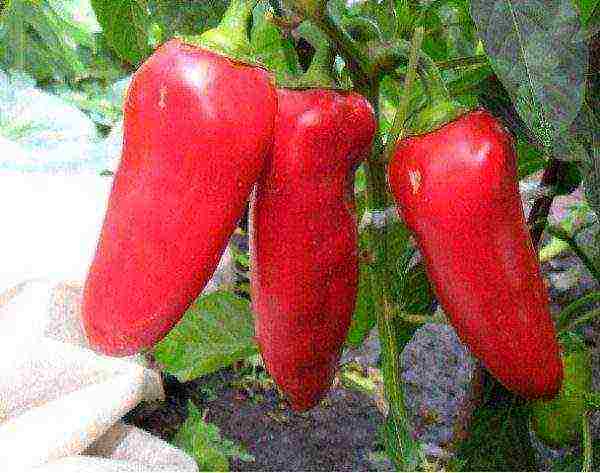 Sweet pepper grade Kupets
Sweet pepper grade Kupets
Medium-sized plant with pyramid-shaped fruits. During biological maturation, they are dark red in color, with a juicy dense pulp.... Peppers are large-fruited, thick-walled.
Mid-season
The varieties of medium ripeness include those the growing season of which occurs in the range from 110 to 130 days... This species is distinguished by the duration of fruiting.
Martin
 Sweet pepper swallow
Sweet pepper swallow
A variety with high seed germination. Fruits are cone-shaped, red. Length of ripe pepper Swallow up to 10 cm... The bush is small, about 50 cm.
Atlant
 Tall variety Atlant pepper
Tall variety Atlant pepper
A tall variety with a fairly large yield. Atlant fruits are large (400g), sweet, deep red, thick-walled (1 cm). Peppers grow up to 20 cm in length... Disease resistant.
Sweet pepper for Siberia
Bell peppers come from hot countries, they like the warm temperate climate.But even in such a harsh region as Siberia, you can grow peppers and get an excellent harvest. There are many varieties for the colder climates. Which ones to use in the area? Summer in Siberia is short, so it is better to use early or mid-early peppers. The most common among them are the following:
Dandy
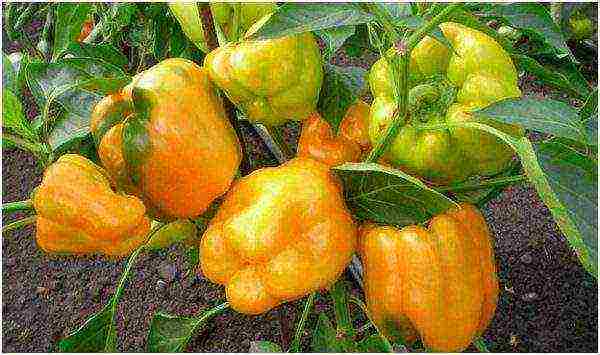 Pepper grade Goldfinch
Pepper grade Goldfinch
An early variety with a low bush (up to 50 cm). The vegetables are cylindrical, dark yellow when ripe... The thickness of the pulp is 5-8 mm.
Moneybags
 Pepper grade Tolstosum
Pepper grade Tolstosum
A new variety bred in Siberia. Resistant to cold, grows well in unprotected soil. Strong bush, up to 60 cm. Ripe red vegetable, large. The thick wall of the pulp tastes sweet and juicy.
Golden Taurus
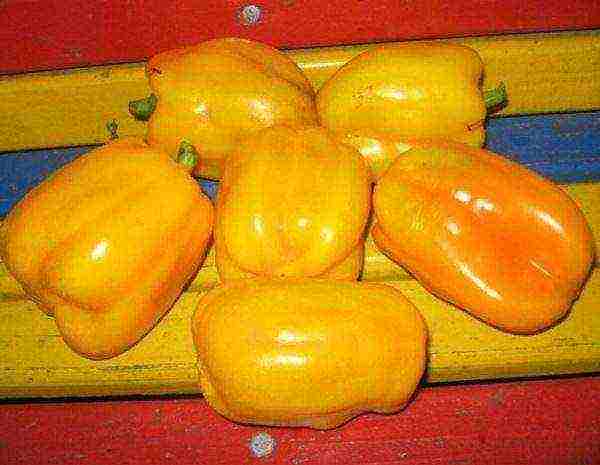 Siberian pepper variety Golden calf
Siberian pepper variety Golden calf
Medium early crop, well suited for growing in Siberia. Bushes of medium height. Fruits are orange, glossy, cuboid... The wall of the vegetable pulp is very thick, up to 20 mm.
Sweet chocolate
 Pepper grade Sweet chocolate
Pepper grade Sweet chocolate
Unusual due to its paint. The fruit is dark brown in color, while the flesh is red inside... The pepper is very juicy and sweet in taste, ideal for preservation.
Varieties for the Moscow region
For the changeable climate of the Moscow region, varieties should be selected that are resistant to a sharp change in temperature. The following are popular among gardeners:
gold medal
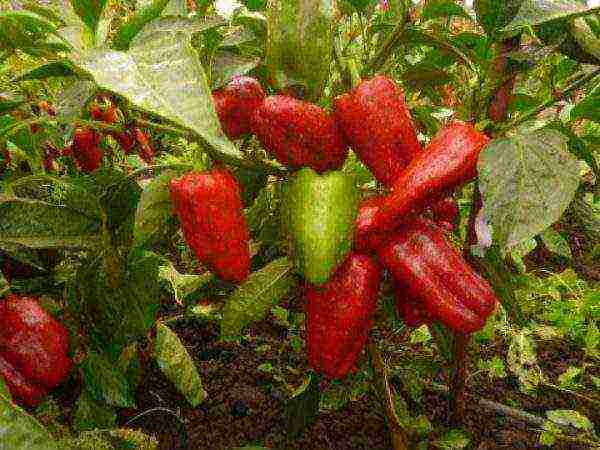 Pepper grade Gold medal
Pepper grade Gold medal
High-yielding, can grow in unprotected soil. The bushes are high (up to 1 m). Fruits are straight, long (up to 13 cm) with an average wall thickness.
Belozerka
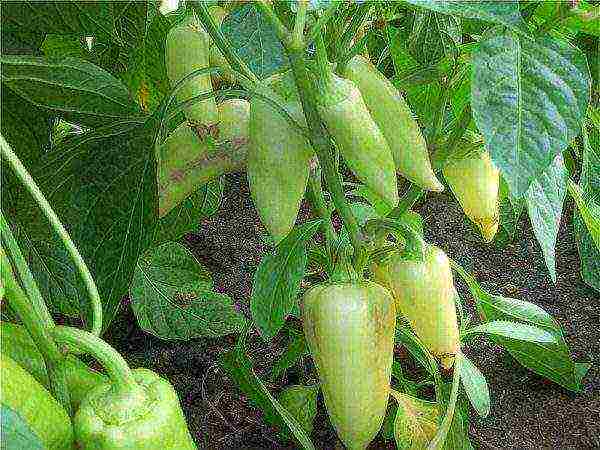 Sweet pepper grade Belozerka
Sweet pepper grade Belozerka
Belozerka is resistant to climate change and has a high yield. Small cone-shaped hearths are formed on low bushes (50-80cm)... The color changes from light green to red towards the end of ripening.
Winnie the Pooh
 Pepper winnie the pooh
Pepper winnie the pooh
The bushes are low, suitable even for the smallest greenhouses. Winnie the Pooh Grows well outdoors. Fully ripens in 100 days. Fruits are small (10 cm), smooth, in the shape of a sharp cone. The color of ripe pepper is bright red, the thickness of the flesh wall is 6 mm.
Gogoshary
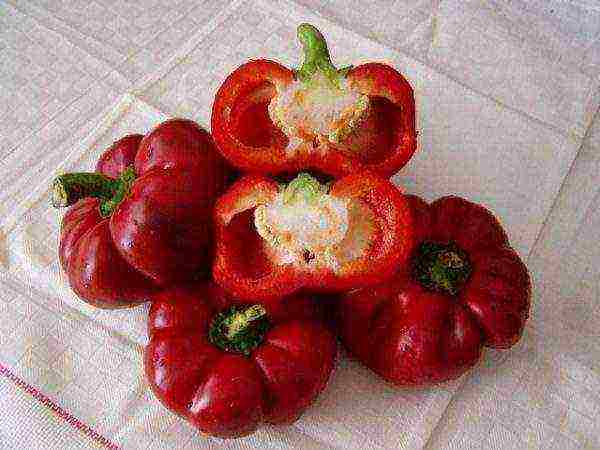 Pepper grade Gogoshary
Pepper grade Gogoshary
Medium early variety (95-100 days). It has an unusual flattened shape, reminiscent of a pumpkin. The bushes are tall, strong (up to 1 m). Fruits are thick-walled, fleshy, dark green at the beginning of ripening, deep red at biological maturity... It has an interesting sweet-spicy taste, good both fresh and after heat treatment.
The best hybrid varieties
The seeds of hybrid varieties are not suitable for further planting. therefore seedlings will have to be bought every year... But such qualities as high resistance to diseases, productivity and impressive size of fruits make gardeners from year to year acquire exactly the seeds of hybrid plants.
Marinkin tongue
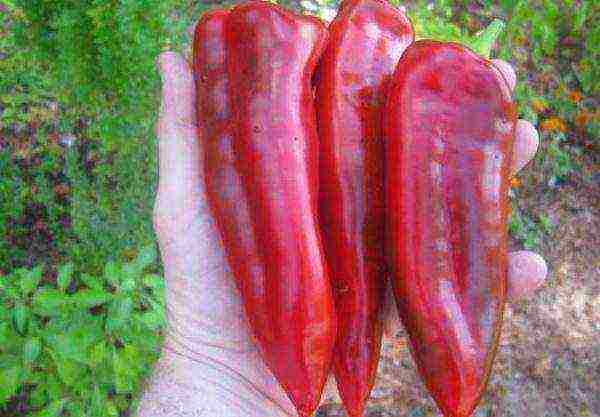 Pepper grade Marinkin tongue
Pepper grade Marinkin tongue
Medium height plant, with rather large fruits (up to 200 g) of a long elongated shape... The taste is sweet, very pleasant, but the shelf life of these peppers is not long.
Triton
 Extra early pepper Triton
Extra early pepper Triton
Incredibly high yield - more than 50 peppers can grow on one bush! The shape of the fruit is conical, the wall is not thick. The ripe fruit is bright red in color, ideal for processing.
Atlantic
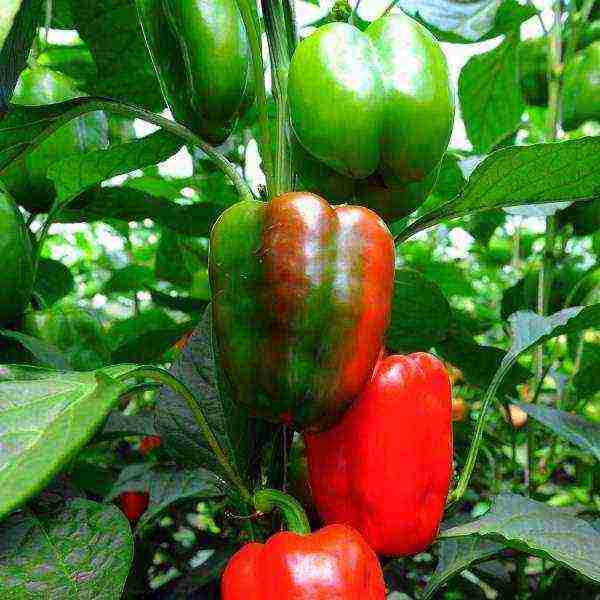 Hybrid pepper variety Atlantic
Hybrid pepper variety Atlantic
The classic representative of culture. Large fruits of bright red color, very juicy and aromatic... It is widely used for preparations and in fresh appetizers and salads.
Description of the best late-ripening peppers
Most suitable for southern latitudes, since they need 140-150 days with good weather to fully ripen.
Hercules
 Pepper Hercules
Pepper Hercules
Stunted, has many large fruits. Ripe Hercules peppers are red, with thick juicy pulp.
Yellow bell
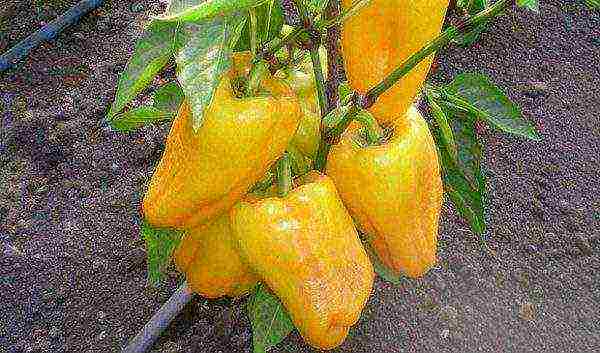 Pepper Yellow Bell
Pepper Yellow Bell
Plant of medium height (up to 75 cm) with large yellow-orange fruits when ripe. Shaped like an inverted bell... It has a thick flesh wall and excellent fresh taste.
Bogatyr
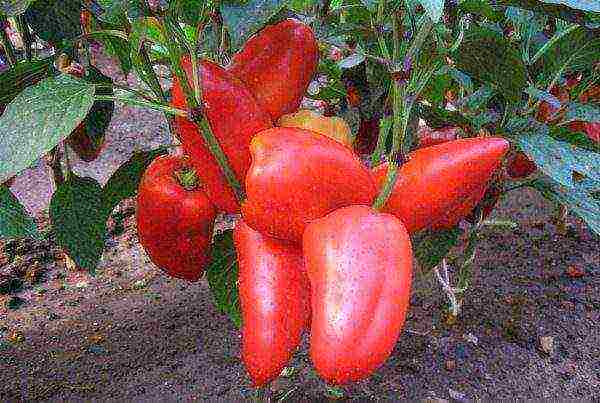 Pepper Bogatyr
Pepper Bogatyr
The hero is not afraid of open ground. Bushes are small, with large fruits. Ripe, cube-shaped pepper of bright red color with juicy pulp, has a great taste and aroma.
Marshmallow
 Pepper grade Marshmallow
Pepper grade Marshmallow
High yielding, vigorous plant (up to 80 cm) with a large number of globular fruits... The pulp is very juicy and sweet. The color changes from deep green to bright red.
Thick-walled large-fruited varieties
Wall thickness and fruit size are decisive factors for most gardeners when choosing seeds. Thick-walled peppers are with a pulp thickness of 6mm. These varieties are great for canning, drying and freezing.
White gold
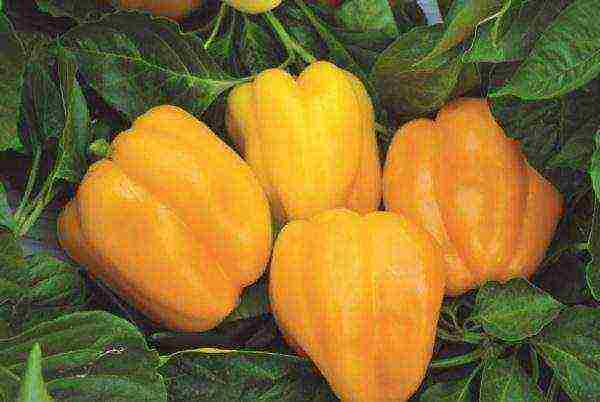 Pepper grade White gold
Pepper grade White gold
Can be planted in open ground. The plant is low, while with very large yellow fruits (up to 450g)... The peppers are cubic in shape.
Siberian format
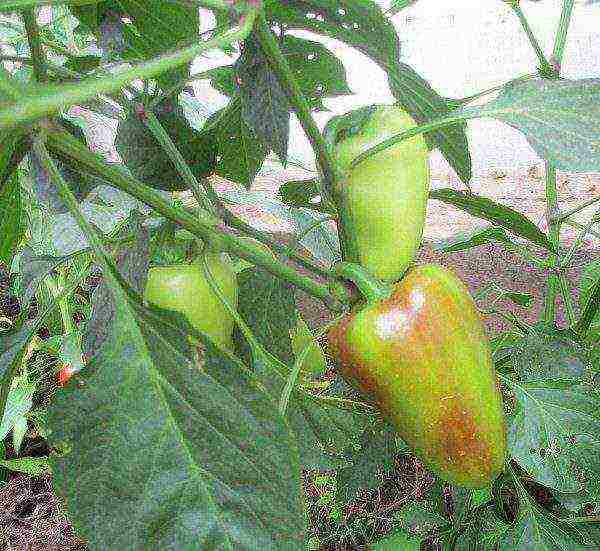 Sweet pepper variety Siberian format
Sweet pepper variety Siberian format
Mid-season, very large peppers grow on tall and powerful bushes. The size of the fruit grown in the greenhouse can be up to 500 g!
Queen
 Sweet Pepper Queen
Sweet Pepper Queen
Fruitful, small fruit (up to 200g) has a thick ruby-red flesh. It perfectly tolerates long-term transportation.
The best peppers for stuffing and processing
Stuffing
 Stuffed bell pepper
Stuffed bell pepper
Pepper is ideal for food stuffing. For this, even, medium-sized peppers of the same size are usually used. Among the early ones it can be noted: Lyubava, Divo, Golden miracle, Banana, Marinkin tongue. Among mid-season: Antey, New Russian, Stepashka.
Drying
Long and elongated fruits are suitable for drying.... Sabelka and Miracle paprika are perfect for this. You can dry them directly in the fresh air.
Canning
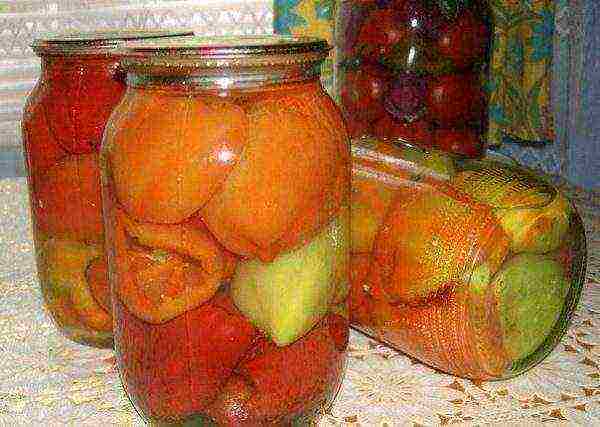 Canned bell peppers
Canned bell peppers
For preservation, it is ideal to use thick-walled fleshy varieties. And if you take a few multi-colored peppers, the preparation will come out not only tasty, but also beautiful. Perfect for canning: Vanguard, Adept, Bogdan, Ideal, Lilac Bell, Chocolat Beauty, Amber.
Conclusion
Bell pepper is an unusually healthy, tasty and beautiful vegetable. It is grown in regions with different climatic conditions - Siberia, Moscow region, Donbass, Crimea and others. Thanks to the bright variety of colors and juicy fresh taste, it will always find a place on the festive table. And in terms of filling with vitamins, pepper is the leader among other vegetables. By eating just one pepper a day, you can replenish your daily supply of vitamins C and E. Bell peppers are called "the vegetable of beauty", because eating it improves the skin and strengthens the hair. Pepper is also good for the eyes, due to the high content of beta-carotene.
